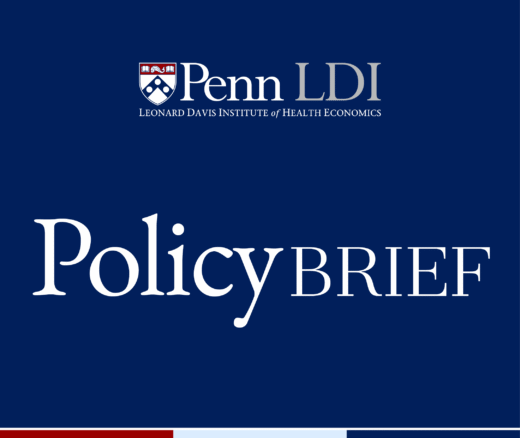
Toward a More Humane and Economically Viable Long-Term Care System
A Penn LDI Virtual Panel Looks Ahead at New Possibilities
Improving Care for Older Adults
Blog Post
In his 2022 State of the Union address, President Biden called for nursing home reforms, noting that “quality in those homes has gone down and costs have gone up.” One attempt at reform was already underway with the Medicare Skilled Nursing Facility Value-Based Purchasing program (SNF VBP) to reduce readmission rates with financial incentives. Indeed, in 2019, the first year that the SNF VBP distributed financial incentives and penalties, many SNFs demonstrated improved readmission rates.
But while the SNF VBP rewarded numerous SNFs that were already performing well at baseline, only a handful of SNFs that performed poorly at the beginning of the program improved enough to avoid a penalty, according to a recent study led by LDI Fellow Robert Burke. Many of these penalized SNFs serve historically marginalized populations, leading Burke and colleagues to conclude that SNF VBP may inadvertently exacerbate health disparities—the opposite of its intended effect.
The Centers for Medicare & Medicaid Services designed SNF VBP as a broad-scale incentive effort to remedy a known cost, safety, and quality issue: Medicare pays more than $28 billion annually for beneficiaries discharged from a hospital to a SNF. Of those patients, nearly one-quarter are readmitted to a hospital within 30 days. In a previous study, Burke and colleagues linked readmission to four-fold higher mortality within 100 days compared to non-readmitted patients.
The initial iteration of the SNF VBP program identified facilities for financial bonuses and penalties based on a single metric: 30-day hospital readmission rates. SNFs were eligible for bonuses (and avoided penalties) if they had a high level of performance on this metric, significantly improved from a baseline measurement of their performance, or both.
By focusing on improvement from baseline, the program was supposed to help historically underperforming SNFs avoid penalties and even earn rewards. The improvement pathway sought to mitigate inequities in care because the lower-performing SNFs with the biggest opportunity to improve tended to serve areas with more racial and ethnic minority populations and patients with lower income.
But when Burke and his coauthors analyzed the data, they found that when bonuses and penalties were awarded in 2019, only 52 facilities (0.7% of SNFs with below-median baseline performance) improved enough to avoid a financial penalty, despite improving their readmission rates. Even SNFs that showed the greatest improvement from baseline mainly received no bonus or a penalty.
SNFs with the highest baseline readmissions were particularly challenged: Those that began in the bottom 25% of readmission rates received an estimated $36,000 penalty, avoided by only six facilities. In contrast, the initially high-performing SNFs that started in the top 25% of readmission rates earned an estimated $38,000 bonus. The study authors concluded that contrary to intentions, SNF VBP helped the “rich get richer” because already high-achieving SNFs were rewarded while SNFs with poor baseline performance were punished, even if they improved their readmission rates.
Despite these discouraging results and a 2021 recommendation from the Medicare Payment Advisory Commission to end SNF VBP, Burke and colleagues note their study has lessons to help the Biden-Harris administration improve nursing home care. Recent White House announcements focus on adding metrics beyond readmission rates, such as on staffing adequacy and retention. Burke and colleagues note that although these changes are worth exploring, a fundamental redesign of the reward and penalty structure is essential to achieving the SNF VBP safety, quality, and equity goals.
They recommend that restructuring of VBP for SNFs should start by finding ways to financially reward—not penalize—-facilities that demonstrate improvement. Most SNFs are for-profit but run very low margins. This means that a poorly designed VBP program could threaten access to nursing home care if penalties cause initially low-performing facilities to close. SNFs, though, are highly sensitive to financial pressures and likely to respond to a more equitable value-based reward structure. Burke and coauthors conclude that VBP “may be a strong lever to drive performance if deployed effectively.”
The study, Skilled Nursing Facility Performance and Readmission Rates Under Value-Based Purchasing, was published in JAMA Network Open on February 28, 2022. Authors include Robert E. Burke, Yao Xu, and Liam Rose.

A Penn LDI Virtual Panel Looks Ahead at New Possibilities

Lessons from the Past, Imperatives for the Future

Technology Helps Older Adults Stay at Home—But May Delay Necessary Transitions to Higher Levels of Care

Her Transitional Care Model Shows How Nurse-Led Care Can Keep Older Adults Out of the Hospital and Change Care Worldwide

Direct-to-Consumer Alzheimer’s Tests Risk False Positives, Privacy Breaches, and Discrimination, LDI Fellow Warns, While Lacking Strong Accuracy and Much More

New Therapies Inspire Hope, Even as Access and Treatment Risks Continue to Challenge Patients and Providers

Penn LDI Senior Fellow Yong Chen Is an MPI in the 10-Institution NIA Undertaking

Precision Diagnostics Give Patients Clearer Answers About What Drives Cognitive Impairment